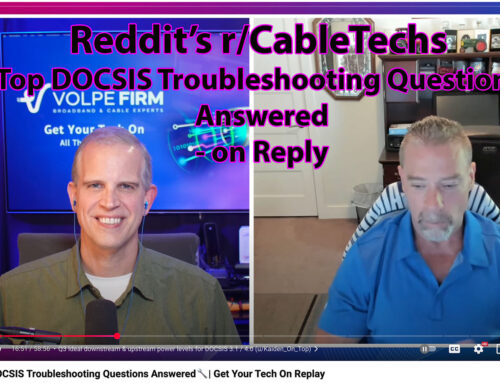Let’s Use Our Coax Smarter
It’s there and you already paid for it
I often hear from subscribers and they ask me about why their network connection is so terrible. When they contact me, they are very frustrated and angry and are confident their cable operator is doing this on purpose. I always stress to them that cable operators really do want them to have a great experience and great service. With that, a reliable network is even more important now than in any time in our history. While network connectivity has increasingly become important, 2020 is a chapter break for us all. Because so many of us are now working and learning from home, peak hours have shifted from late evening towards afternoons and we don’t know how long e-learning for children will continue in most areas. We all are eagerly awaiting a vaccine which might be one shot or many shots over many years but e-learning, telemedicine and working from home are probably here to stay in greater numbers, so our networks need to be more reliable than ever. Reliability is also a function of capacity. As networks are pushed towards higher utilization by subscribers, they are increasingly eating into what used to be excess network capacity. Subscribers will feel the effects of an imperfect network due to shrinking overhead. In other words, if we continue to cram more data into a fixed pipe, there is less room for error.

Source: https://www.ncta.com/COVIDdashboard
In the U.S. there are over 72 million businesses and households using broadband services.[1] Since COVID-19 has led to more social distancing and also an increase in working from home, our broadband services are even more important. I’m a big fan of proactive network maintenance (PNM). It has been around for quite a few years now and there are several vendors offering different solutions with varying options and capabilities. PNM is about finding and fixing issues in the network before they impact the subscribers. This is even more important in today’s world where subscribers are relying on great service and cannot afford to have an outage during an important video conference call with a customer, their doctor or have kids not e-learn for hours or days on end while an outage gets alerted or reported… to then be dispatched… to get troubleshot… and ultimately resolved. Alerts in today’s cable network alone are no longer good enough — an alert means that someone is already feeling the impact of bad service or is out of service. Operators need to know about issues before they impact subscribers. In my last article “Supporting Subscribers During a Pandemic” I wrote about some of the useful ways PNM can help operators in our new COVID-19 world. From subscriber self-installs, which companies like Comcast are actively promoting, to testing by CSRs of the network before the cable modem is sent to the subscriber to ensure a good self-install, etc., I wanted to continue to expand on this.
What about capacity?
Several operators have great success with PNM. PNM is a very useful application in today’s COVID-19 world by helping with capacity management via a more perfect network. Capacity has always been an issue for operators but now where operators used to feel they had wiggle room, that has now evaporated. PNM can help operators with capacity by helping them achieve a very reliable network because previous left-over capacity has now been utilized. No, PNM will not get you more capacity, it will help you with the wiggle room by helping you eliminate trouble in your network. An example of this is getting visibility into impairments such as corrosion or water in coaxial cable, which can affect performance in your network. PNM allows you to see performance degradation before those impairments affect your subscribers. Once you identify an issue you can take action on it and fix the problem via regular maintenance. Alternatively, you could wait until you get the “Alert” which tells you that now that corrosion or water in the coax has taken 50 subscribers offline. The right choice is to fix the problem before those 50 subscribers lose their Internet connection — which in today’s world is their primary connection to work, school, doctors, friends and family.
PMA
Profile management application (PMA) is another great tool created by CableLabs.PMA uses data from cable modems to optimize DOCSIS 3.1 orthogonal frequency division multiplexing (OFDM) signals in order to increase the downstream data capacity in the presence of RF impairments. This is done by monitoring the receive modulation error ratio (RxMER) per OFDM subcarrier from each cable modem — aka we monitor the receive signal quality of each modem. Once we know how well each modem is receiving the downstream OFDM signal we can then fine-tune the cable modem termination system (CMTS) to ensure every cable modem is receiving the optimal OFDM signal and thus the optimal performance for that subscriber’s modem.
Furthermore, it becomes even more important in the upstream. When running orthogonal frequency division multiple access (OFDMA) in the upstream, we have many modems transmitting OFDMA signals to the CMTS. In this case, PMA must analyze each upstream signal from the cable modems. Then PMA will optimize each cable modem’s transmission so that upstream throughput is maximized in the presence of impairments.
One can consider PMA like a feedback loop for your CMTS in the downstream and your cable modems in the upstream when using DOCSIS 3.1 OFDM and OFMDA signals. It performs this feedback loop by constantly monitoring signal quality on the downstream and upstream. Then PMA tunes the CMTS and cable modems and optimizes modulation order to keep data throughput as high as possible. This is something traditional test equipment cannot do.
Use your coax smarter
With each version of DOCSIS there have been fantastic improvements and performance extensions such as more powerful error correction (LDPC), more bandwidth, higher order modulations, profile management, pre-equalization, full band capture and more. Furthermore, PNM allows operators to proactively identify and resolve issues before a failure or service degradation is noticed by a subscriber.
Continue reading at Broadband Library
Read previous articles below.





Leave a Reply